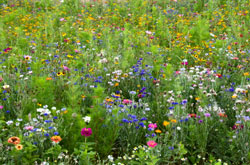Report Reveals Extensive Loss of Wildflowers
 A recent report by a leading nature charity has revealed that Britain has lost 10 wildflower species since the Queen came to the throne 60 years ago.
A recent report by a leading nature charity has revealed that Britain has lost 10 wildflower species since the Queen came to the throne 60 years ago.
The research carried out by Plantlife, showed that wildflowers were disappearing from the British countryside at a rate of up to one species a year and could eventually lead to total extinction on a national scale.
The study looked at the rate at which flowers were being lost from 50 counties in England, Scotland and Wales and found some, such as field gentian and burnt orchids, were disappearing while once-widespread plants were becoming rarer.
Summer lady’s tresses, downy hemp-nettle, and interrupted brome are among the 10 species that have completely vanished across Britain in the last six decades, leading Plantlife to warn that, without protection, critically endangered flowers such corn buttercup, fringed gentian and the yellow early marsh orchid could be next to disappear.
Dr Trevor Dines, Plantlife Cymru’s conservation director, said: “There’s something that’s happening in our back fields and the hedgerows around us – we’re seeing the common things becoming rarer and the rare things disappearing. In the 1950s, the fields would have been richer in colour, the hedgerows would have been richer in colour and the arable fields as well, you would have seen more poppies, been more aware of flowers, they would have been part of life.”
He said action needed to be taken or more plants would vanish at a national level and warned that wild native plants were needed to support the rest of Britain’s wildlife, including bees, butterflies and farmland birds.
“Plants are the fundamental building blocks of our countryside,” he said. “Our landscape is constructed from plants and it’s the diversity of these plants that supports, nourishes and sustains everything else.”


